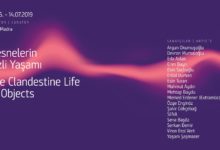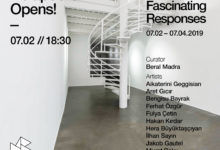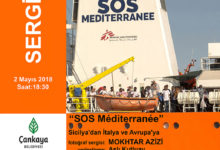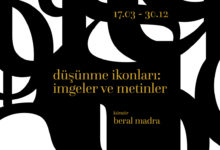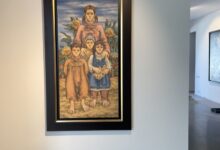
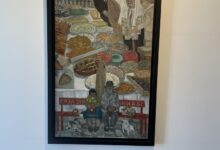
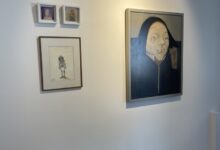
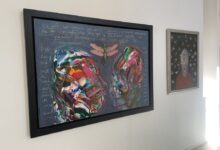
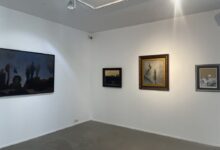
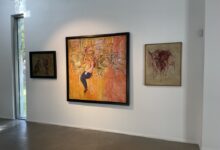
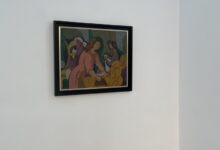
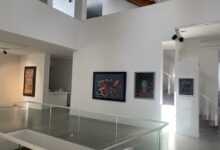
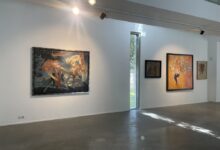

Sanat ve Hayat
Evliyagil ve Değirmenci Koleksiyonlarından On Sekiz Sanatçının Resimlerinden Bir Seçki
Bu sergide yer alan sanatçıların çoğu mesleklerine 1940’lı ve 1950’li yıllarda başlamıştır; hepsi 1960’lı ve 1970’li yılların toplumu sağ ve sol olarak ikiye bölen politik ortamını yaşamış; bu da sanata toplumsal gerçekçilik, soyutlama ve dışavurumculuk olarak yansımıştır. Daha sonra 1980’lerde figüratif sanat yeni dışavurumculuğun yolunu açtı. Bu akımlar, sanat akademisinin sınırları içinde ve yakın galeri çevrelerinde, çoğunlukla o dönemin sol ideolojisini destekleyen çok küçük bir sanatçı grubu tarafından uygulanmıştır. 1945-1980 döneminin resim üretimi de Taşizm, İnformel, Geometrik, Lirik, Dışavurumcu Soyutlama gibi birçok biçimiyle küresel soyutlamanın etkisi altındadır. İkinci Dünya Savaşı’ndan sonra Türkiye’de Modern yaşam, Modern sanat ve kültür, bir grup sanatçı Paris’teki eğilimleri izlese bile, yüzünü ABD’ye çevirmiştir.
1970’lerin ortasından 1980’lerin ortasına kadar olan dönemde Türkiye, Sovyetler Birliği ve Amerika Birleşik Devletleri’nin soğuk savaş politikalarının oyun alanı içindeydi. Sovyet yanlıları ve Amerikan yanlıları, kendi içlerinde de parçalanmış olarak, sokaklarda birbirleriyle savaştılar ve birbirlerini yok ettiler. Bu dönemde Türkiye’nin ulus devlet ve laiklik ortamı, muhafazakâr ya da liberal sağ veya çok yüzlü sol olarak ikiye bölünmüş ve demokrasisi zayıflamıştır. Bu iki kamp arasındaki şiddetli mücadeleler içinde edebiyat ve sinema, yaratıcı üretimin önyargılı alanlarıydı, öyle ki birçok yazar ve sinemacı hapse girdi. Ancak anıtsal, ulusalcı ve kahramanlık örnekleriyle heykel üretimi devletin hizmetindeydi. Soyutlama örnekleri kamusal alanın dekorasyonunda da kullanıldı. Resim, muhalif biçimleriyle, yani toplumsal gerçekçiliğin görsel tezahürü olarak, solcu seçkinlere güçlü bir şekilde hitap edebiliyordu.
O dönemin jeopolitik bağlamı çağdaş sanatçıları önemli ölçüde etkilemiştir. “Kültürel göçebelik” ve ‘farklılık’ temel konulardı ve Türk sanatçısının oldukça karmaşık olan jeopolitik konumuna da işaret ediyordu. Türkiye’de sanatçı “farklılık” topraklarında yürürken bu yüzyıl boyunca göçebe olma olgusunu ve farklı bir kültürü farklı bir kültüre nasıl aşılayabilir ve farklı bir kültürle nasıl demlenebilir diye sorguluyordu. Sanatçılar tarih içinde bir yolculuğa çıkıyor ve yeniden bugüne dönüyordu. Günümüz hala geçmişten etkilenmekte; geçmiş, hem bir kimlik kaynağı hem de bir ikilem kaynağıdır. Ancak kimlik aynı zamanda ikilemden de beslenir. İkilem, sanatçının gelenek ve modernizm arasında bir gezgin olduğu yaratıcı ve üretken bir arayış alanıdır. Bu süreç, Post-Modern durum, merkez ve çevre kavramının değişimi, zapt etme ve boyun eğdirmenin katı durumunun, bir kültürel çevreden diğerine aktarım durumuna dönüşmesiyle, yani küresel iletişim olarak adlandırılan olguyla genişler.
Figüratif resim, soyut arayışlara güçlü bir zıtlık içindeydi. Ressamlar sosyalizmi savunuyor, kırsal kesimdeki ayrımcılığı ve alt sınıfların marjinalleşmesini gösteriyordu. Israrla Anadolu gerçeğini, halkın yoksulluğunu, ıstırabını ve umutsuzluğunu sergiliyorlardı. Nurullah Berk, Neşet Günal ve öğrencisi Neşe Erdok, dönemlerinin en önde gelen figüratif ressamlarıydı. Öte yandan, Mehmet Güleryüz, Komet ve Aladdin Aksoy, aynı toplumsal sorunları ele alırken Sürrealizm ve Yeni-Ekspresyonizmde öncülük ederek daha tekinsiz bir tarzı tercih ettiler. Hakan Gürsoytrak ise bu öncülerin takipçisidir; önemli politik, eleştirel, toplumsal üretim ve manifestoya dayanan muhalif ve bağımsız bir girişim olan Hafriyat’ın kurucusudur.
Bu on yılların şiddetli siyasi ve toplumsal çalkantıları içinde bir grup ressam, protestolarını yapıtlarıyla gösterdi; bunlar özellikle figüratif resimler, toplumun bireysel ve toplumsal çelişkilerini, kültürel yozlaşmayı ve gelecek kaygılarını yansıtmıştır. Gerçeklik zeminine sahip ve anlatımla dolu bu resimlerin tarzları, Geç Modern tarzlardan Ekspresyonizm, Yeni-Ekspresyonizm ve Kötü Resim akımına kadar çeşitlilik gösterir. Ancak Orhan Peker, 1960’lar ve 1970’lerin Ekspresyonizminin önde gelen temsilcisiydi; çocuk, at ve kedi imgeleriyle umutlu ve iyimser bir dünyayı yansıttı. Cihat Burak’ın birçok resminde ise insan imgesi kara mizah, grotesk sahneler ve nesnelerle doluydu. O, tüketim toplumunun arzularını ve İstanbul’un tarihi dokusunu gözler önüne serdi. Tüm bu resimler izleyicilerle bir diyalog arayışındaydı.
Toplumsal Gerçekçilik, Yeni Gerçekçilik, Pop Art, Fluxus, Minimalizm ve Kavramsal Sanat gibi Geç Modernist akımlar yavaş yavaş İstanbul sanat sahnesine ulaştı ve nispeten küçük bir sanatçı grubu tarafından benimsendi. Altan Gürman, Yeni Gerçekçi sanat üretimiyle, siyasal, toplumsal ve ekonomik gerçeklikleri, günlük yaşamı yansıtan bir sıçrayışın öncüsüydü. Sanat üretiminde çözümlemeli ve kavramsal bir yaklaşım geliştirdi ve akademide temel tasarım ve sanat bölümünü kurarak, bir sonraki kuşağın kendi zamanlarının gerçekliğiyle bütünleşmesinin yolunu açtı.
Yüksek sanat yapıtları ile popülist sanat eserleri arasındaki sınırlar izleyiciler tarafından açık bir şekilde ayırt edilmediğinden, bazı sanatçılar çağdaş sanat estetiğini geleneksel ve hayranlık uyandıran kültür imgeleriyle buluşturmaya özen gösterip, geleneksel sanat biçimlerini sunmayı yeğlediler. Bunlar arasında Ergin İnan, resimlerinde İslam sanatı biçimlerine ve felsefesine güçlü göndermeler taşıdı. ABD’de yaşayan Burhan Doğançay ise Pop-art etkilerini ve soyutlamayı temsil etti; ancak sergilerle Türkiye’ye olan bağlılığını sürdürdü ve şehre özel bir müze kazandırdı. Yüksel Arslan, 23 yaşındayken Paris’e taşınan bir sanatçıdır. 1960’tan önce bile, benzersiz illüstratör çizgisel tekniğiyle ürettiği resimlerle politik, ekonomik ve kültürel çözümlemeler ve eleştiriler yapmıştır. Kapitalizm ve Marksizm üzerine derin bir bakış açısına sahip erken bir öncü olarak kabul edilmiştir.
Osmanlı İmparatorluğu’nun Batılılaşma programı ve güzel sanatlar akademisinin kurulması, üst sınıf ailelerin kızlarının sanat eğitimi almasına olanak tanımıştır. Türkiye, erken modernleşmiş İslam ülkelerinden biri olduğu için Batı bakışı, Türkiye’den kadın sanatçıların konumunu da sembolik bir konuma sabitlemiştir. Gerçekten de kadın sanatçılar, Modern sanatın ortaya çıkışında sınırlı bir feminist dokunuşla önemli bir rol oynamışlardır. Katı ataerkil koşullar ve erkek egemen sanat sahnesinde, kadın sanatçıların tutumu bir sonraki nesil için girişimci olmuştur.
20. yüzyılın Modernizmi, Batı-dışı sanat sahnelerinde zamanında kaydedilmiş olsaydı, Fahrelnissa Zeid, Jackson Pollock ve çevresi gibi Soyut Dışavurumculuk sanatçılarıyla karşılaştırıldığında erken bir soyut dışavurumcu olarak anılırdı. O, modernist kanonu İslami motiflerin manevi karmaşıklığı ile birleştirmenin olanaklarını araştırdı. Daha sonra, 1970’lerde Amman, Ürdün’e taşındığında, ünlü arkadaşlarının ve çevresinin portrelerini İslam ve Bizans etkilerini harmanlayarak resmetti. Semiha Berksoy, figüratif ve neredeyse Neo-Dışavurumcu resimleriyle erken dönem feminizmi gündeme getiren bir sanatçı olarak, Türkiye’deki kadınların özgürleşme tarihinin öncülerinden biri olarak anılmalıdır. 1936’da Romanya doğumlu sanatçı Eren Eyüboğlu, Bedri Rahmi Eyüboğlu ile evlenerek D Grubu’na katıldı. Peyzaj ve figüratif resimlerinde, Anadolu’nun doğasına ve toplumsal yaşamına odaklanarak folklorik unsurlar ve dışavurumcu estetik kullandı. Şükriye Dikmen, ünlü portre sanatçısı Feyhaman Duran’ın desteğiyle 1940 ile 1948 yılları arasında Güzel Sanatlar Akademisi’ne katıldı ve D Grubu’ndan etkilendi. Daha sonra Paris’te eğitim aldı ve Fernand Léger tarafından yetiştirildi. Dikmen, Avrupa deneyiminin etkisi altında, güçlü bir sadelikle genç kızların ve kadınların cepheden portrelerini yaptı; bu eserler, minimalist bir yüz yüze yaklaşım ve kadınların dayanıklı feminist gücü olarak değerlendirilebilir. Bu dönemlerdeki kadın sanatçıların çoğu, erkek egemen sanat sahnesinin gölgesinde kalarak, 1990’larda Modernist ikiliğin sona ermesinden sonra keşfedilip takdir edilmiştir. Ancak, 1970’ler ve 1980’ler boyunca Neşe Erdok, toplumsal gerçekçilik hareketinde kararlı bir şekilde erkek meslektaşlarının arasından güçlü bir şekilde sıyrılmıştır; toplumun farklı kesimlerinden insanların görüntülerini sınıf ayrımı açısından yorumlaması, günümüze kadar uzanan benzersiz bir gerçekliği gözler önüne sermektedir.
1980’lerin ortalarında devlet kapitalizminden liberal kapitalizme doğru gerçekleşen siyasal ve ekonomik dönüşümler doğrultusunda, görsel sanatçının beklentileri ve kimliği daha bağımsız ve muhalif bir değer kazanmıştır. Sanatçılar, sanatın işlevi ve bireysel mitolojiler gibi diğer konuların yanı sıra, Oryantalizm ve Avrupa-merkezcilik etkili Modernizmin ikilemlerini yeniden düşünme ve geleneksel sanatları yeniden değerlendirme peşindeydiler. Büyük kentlerin kırsal nüfusunun popüler kültürü, disiplinler arası sanat üretimi için bir ilham kaynağı olarak kullanılmıştır. Modernizm ve Post-modernizmin ilkeleri ve fikirleri, sanat eserlerinin üretimi ve yayılımındaki tüm zorlukların üstesinden gelmek için her zaman etkili bir araç olmuştur, özellikle de siyasi, ekonomik ve toplumsal çalkantılar bağlamında.
ART AND LIFE
A Selection of Paintings of Eighteen Artists from Evliyagil and Değirmenci Collections
Most of the artists in this exhibition have started their career in 1940’s and 1950’s; all of them lived through the political environment of the 1960’s and the 1970’s, which divided the society into, left and right; this was correspondingly reflected in the art as Social Realism, Abstractionism and Expressionism. Later in 1980’s the figurative art opened the way to New Expressionism. These movements were practices within the boundaries of the art academy and in close gallery circles by a very small group of artists, mostly supporting the Left ideology of that time. The painting production of the period of 1945‐1980 is also under the influence of global abstraction in its many forms, Tachism, Informal, Geometric, Lyric, Expressionistic Abstraction. After the 2WW, concerning Modern life, Modern art and the culture in Türkiye turned its face to USA, even if a group of artists were following the trends in Paris.
The period between the middle of 70’s to middle of 80’s Türkiye was the playground of Soviet Union and United States cold‐war policies. Pro‐soviets and pro Americans, also fragmented in themselves, fought and exterminated each other in the streets. During this period Türkiye’s nation state and laicism environment was divided into the conservative or liberal right and multi-faced left all with a reduced democracy. Within violent battles between these two camps literature and cinema were prejudicial fields of creative production so that many writers and cineastes were in life‐long jails. However, sculpture production with its monumental, nationalistic and heroic examples was in the service of the state. Its abstract examples were also used for decoration of the public space. Painting, in its dissident forms, namely as visual manifestation of Social Realism, could strongly addressed the leftist elites.
The geopolitical context of that period significantly influenced the contemporary artists. “cultural nomadism” and “difference”; were the key subject and also indicated the geopolitical position of the Turkish artist, which was quite complicated. The artist in Türkiye has been walking on the territory “difference”; throughout this century, questioning the fact of being a nomad and how to implant a different culture with a different culture and be infused by a different culture? Artists were journeying into the history and back to the present. The present was still influenced by the past; and the past is a source of identity as well as a source of dilemma. However, identity is also nourished by dilemma. The dilemma is a territory of creative and productive quest in which the artist is a wanderer between tradition and modernism. This process is extended by the Post-Modern situation, by the change of the concept of center and periphery, by the change of the intransigent situation of seizure and submission into the situation of transference of one cultural environment to another, which is called global communication.
Figurative painting was in strong disparity to the abstract pursuits. The painters advocated socialism and indicated the rural discrimination as well as the marginalization of the lower classes. They persistently displayed Anatolian reality, the poverty, agony and hopelessness of the masses. Nurullah Berk, Neşet Günal and his student Neşe Erdok were the most prominent figurative painters of their time. Mehmet Güleryüz, Komet and Aladdin Aksoy on the other hand preferred a more sophisticated style in depicting the same social problems by pioneering in Surrealism and New‐expressionism. Hakan Gürsoytrak is the follower of these pioneers; he was the founder of Hafriyat (Excavation) a dissident and independent initiative based on substantial political, critical, social production and manifestation.
Within the fierce political and social upheavals of these decades a group of painters showed their protests with their paintings. Since almost two decades, mainly figurative paintings reflect the individual and sociological controversies of the society, anxiety for cultural decay and environmental pollution. The styles of the paintings, most of them with a background of truth and full of narration, vary from late modern styles, from Expressionism, New-Expressionism to Bad Painting. However, Orhan Peker was the prominent representative of Expressionism of the 60’s and 70’s; with his children, horse and cat images he reflected hopeful and optimistic world. The image of human in many paintings of Cihat Burak were full of black humor and grotesque settings and artifacts . He showed the consumer societie’s desires as well as the historical environment of Istanbul. All these paintings seeked out a dialogue with the audiences.
Late Modernist movements such as Social Realism, New realism, Pop Art, Fluxus, Minimalism and Conceptual Art movements gradually reached Istanbul art scene and were practiced by a relatively small group of artists. Altan Gürman was the pioneer of this leap to the new art making which was based on social and economic realities, on daily life and consumerism. He established an analytical and conceptual approach to art making and opened the basic design and art department in the academy which opened the way of the next generation to get integrated into the actuality of their time.
As the boundaries between the high art works and the minor art works are not clearly discriminated by the audience, some of the artists are very careful to bring the aesthetic of the contemporary art in contact with the imagery of the traditional and admired culture. They rather preferred to seek out traditional art modes. Among them Ergin İnan conveyed with their painting’s strong references to Islamic forms and philosophy. The Pop-art influences and abstraction was represented by Burhan Doğançay, who lived in USA, but continued his commitment to Türkiye with exhibitions and bestowed the city with a private museum. Yüksel Arslan is the other artist who moved to Paris when he was 23 years old. Even before 1960, he made political, economic and cultural analyses and criticisms with his paintings produced with his unique illustrator linear technique. He was considered as an early protagonist with a deep perspective on capitalism and Marxism.
Within the Westernization program of the Ottoman Empire and the foundation of the academy of fine arts opened the way to the upper-class families to allow their daughters to be educated in art. As Türkiye is one of the most modernized Islamic countries, the Western gaze also fixes the position of the women artists from Türkiye into an emblematic position. Indeed, the women artists played a significant role in the emergence of Modern art with a restrained feminist touch. In the strict patriarchal circumstances and male dominated art scene the attitude of women artists was enterprising for the next generation.
If the Modernism of 20th century peripheral art scenes were registered in its time, Fahrelnissa Zeid would be mentioned as an early abstract expressionist, in comparison to Abstract Expressionism such as Jackson Pollock and his circle. She set on the possibilities of merging the modernist canon with the spiritual intricacy of Islamic motives. Later in 1970’s when she mowed to Amman, Jordan, she painted portraits of famous friends and her entourage fusing Islamic and Byzantine influences with modernism. Semiha Berksoy with her figurative almost Neo-Expressionistic paintings that bring an early feminism to the agenda should be mentioned as pioneers in the long history of women emancipation in Türkiye. In 1936 Eren Eyüboğlu, a Romanian born artist, married Bedri Rahmi Eyüboğlu and joined D Group. In her landscape and figurative paintings, she focused on the nature and social life of Anatolia and used folkloric elements and expressionistic aesthetic. Şükriye Dikmen attended the Fine Arts Academy between 1940 and 1948 with the support of the famous portrait artist Feyhaman Duran, and was influenced by Group D. Later she was educated in Paris and trained by Fernand Léger. Dikmen, under the influence of her European experience, painted frontal portraits of young girls and women with a strong simplicity, which can be considered as a minimalist face-to face and rigorous feminist power of women. Most of the women artists of these decades remained in the shadow of a male-dominated art scene, to be discovered and appreciated after the closure of Modernist dichotomy during the 90’s. However, throughout the 70’s and 80’s Neşe Erdok powerfully stood out among her male colleagues determined in the social realism movement; her interpretations of images of people from different segments of society in terms of class-distinction demonstrate an unprecedented reality that extends to the present day.
In accordance with the political and economic transformations from state capitalism to liberal capitalism in the middle of the 80’s the prospects and identity of the visual artist has achieved a more independent and dissident status. The major pursuits of the artists among other issues such as the function of art and individual mythologies were rethinking on the dilemmas of modernism of Orientalism and Eurocentrism, and re-evaluating the traditional arts. The popular culture of the rural population of the big cities was employed as a source of inspiration for interdisciplinary art making. The principles and ideas of Modernism and Post-modernism was always an efficient apparatus to overcome all difficulties in production and dissemination of artworks within the political, economic, social turmoils.
Beral Madra
Ekim 2024-Ağustos 2025
October 2024- August 2025


